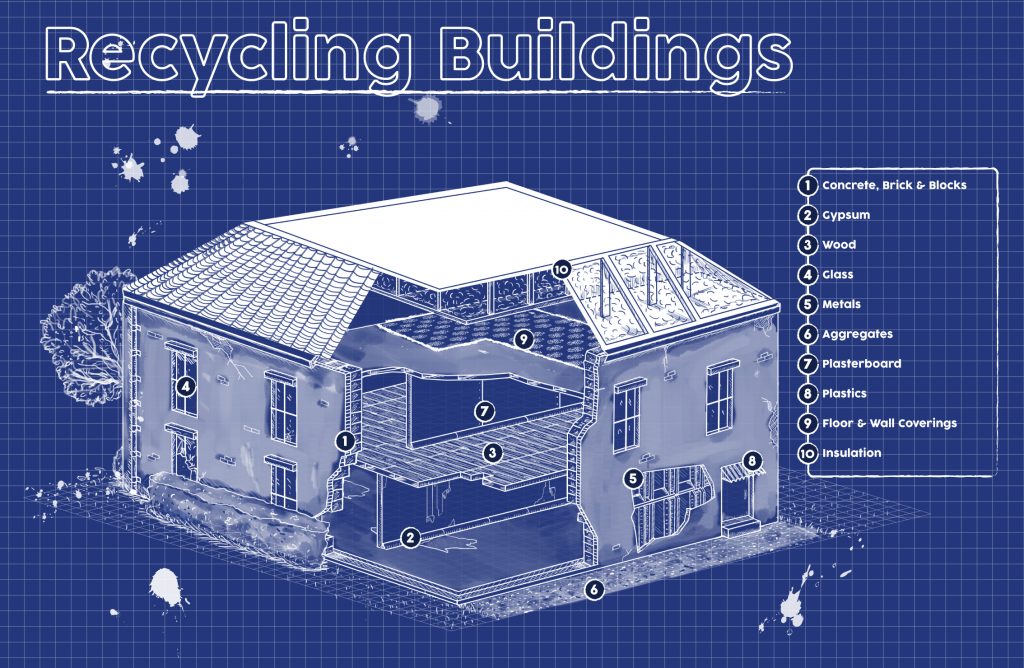
Construction and demolition waste are one of the heaviest and most voluminous waste streams generated in the EU accounting for approximately 25%-30% of all waste generated.
Demolition recycling is an important step in a building’s life cycle, as material reclamation and good recycling practices can divert over 90% of the building’s material from the landfill. RubberBond have been investigating what materials can be recycled and what they can be turned into.
Concrete, Bricks & Blocks
Research indicates that the average wastage level of concrete is about 4%, while brick and block is around 6%.
Method
Concrete and brick can be recycled by crushing them into rubble.
Repurpose
Once sorted, screened and contaminants are removed, reclaimed concrete or brick can be used in concrete aggregate, fill, road base, or riprap.
Gypsum
Stat
The landfilling of gypsum and other wastes with a high sulphate content together with biodegradable waste has been banned in England and Wales since July 2005. This is to prevent the build-up of hydrogen sulphide gas which is both toxic and odorous.
Method
Gypsum is relatively easy to recycle. Contaminants need to be removed, such as screws and nails, and separate the paper.
Repurpose
It can be ground into a powder or turned into pellets. The resulting material is sold to manufacturers that use gypsum for different applications.
Wood
Stat
Wood waste from all sorts of building sites – including new builds and refurbishments – amounts to around 0.85mt per year.
Method
Wood can be reused, repurposed, recycled, or burned as bioenergy.
Repurpose
Wood can be used in pathways, coverings, mulches, compost, animal bedding, or particleboard.
Glass
Stat
The UK manufactures 750,000 tonnes of flat glass each year, three-quarters of which goes into glazing products for buildings. Currently, the recycled content of flat glass produced in the UK is between 20%–30%.
Method
There are various methods of recycling glass in order to make it fit for repurposing such as crushing, screening to remove contamination, air classification, optical sorting, size classification and washing and drying.
Repurpose
Glass can be used for pretty much anything including decorative materials, a fluxing agent in the manufacture of bricks and ceramics, insulation, containers and even sports turf applications.
Metals
Stat
Britain exports 15 million tonnes of industrial waste each year, half of which is valuable scrap metal.
Method
Metals are collected, sorted and then shredded. The scrap is then melted and purified and finally allowed to cool to solidify.
Repurpose
Metals—including steel, copper, and brass—are valuable commodities to recycle. Like glass, they can be repurposed into a vast array of items such as appliances, furnishings, fixtures and lighting.
Aggregates
Stat
Approximately 275 million tonnes of aggregates are used each year in the UK as raw construction materials, but a lot of it goes to landfill.
More than half (54%) of waste recorded as ‘Recycling and other recovery’ is ‘Mineral waste’, while a further 12% is ‘soil’.
Method
Concrete aggregate collected from demolition sites is put through a crushing machine. Crushing facilities accept only uncontaminated concrete, which must be free of trash, wood, paper and other such materials.
Repurpose
Aggregate can be reused as a base material under foundations, roads and railroads.
Plasterboard
Stat
Up to 1.3 million tonnes of plasterboard waste is generated within the new-build construction and refurbishment sectors each year.
Method
Composting.
Repurpose
Standard plasterboard, which hasn’t been contaminated by paint or something similar, can be added to an anaerobic composting system and is likely to have a neutral or beneficial effect when added to the soil, especially clay soil.
Plastics
Stat
According to National Geographic and the National Geographic Society, 91% of plastic isn’t recycled.
Method
All plasterboard recycling goes through a thorough process which takes away all of the added material which is left on the plasterboard when it’s removed from the wall or ceiling.
Repurpose
In construction, plastics are generally used for pipework, interior fittings, window frames, scaffolding boards and kerbstones. These can be repurposed into packaging, textile fibre and clothing, street furniture to name only a few.
Floor & Wall Coverings
Stat
Almost 600,000 tonnes of flooring is disposed of each year, of which less than 2% is recycled. A small quantity is incinerated but the vast majority, over 90%, goes to landfill.
Method
Fibresolve – subjecting wood fibre to a vacuum and pressurised steam with mechanical agitation at a high temperature.
Microrelease – using microwaves to reclaim wood fibres from the resin.
Thermohydraulic processes – separating the adhesive from the wood fibres.
Repurpose
There tends to be a lot of wastage when it comes to floor and wall coverings due to over ordering, pairing this with the fact that a lot of it can also be recycled afterwards, materials such as ceramic and terrazzo tiles, wallpaper, carpet, carpet tiles, vinyl and linoleum, and laminate flooring can be repurposed into many things including road cone manufacturing and animal bedding material.
Insulation
Stat
In just 23 housing projects in the UK, the average amount of insulation wasted was 1.0m3 per 100m2 floor area.
Method
Insulation can be recycled by returning materials through take-back schemes offered by manufacturers, but reclamation and reprocessing can only happen after removing impurities such as nails and screws.
Repurpose
Similarly, materials involved in insulation such as glass and stone wool, polystyrene, sheep’s wool, spray foam, polyurethane and fibreboard can be transformed into concrete blocks, fibreglass board and fibreglass ceiling tiles.
You may also like
8 Sustainable Innovations that are Shaping the Construction Sector
Incredible Eco-Houses that Can Fight Climate Change
How Green Construction Can Help Us Save the Earth
